This was published 3 years ago
Nail your technique, go the distance: Your complete guide to running
What makes a runner’s body? Every body. When we are starting out for the first time or for the first in a long time, it certainly doesn’t feel that way, but with the right support we can all unleash our inner runner – and get a taste of that elusive runner’s high.
By Sarah Berry and Sophie Aubrey

Credit: ILLUSTRATION BY Monique Westermann
Starting nice and easy, over five weeks we will warm up our bodies and get moving. With experts guiding the way, this plan will kickstart your running journey – or if you’re already running, take it a step further. From nailing your technique and preventing injury, to choosing the right fuel and gear, consider this your training toolkit. So, what are you waiting for? Let’s do this – together.
Your training program
Running coach and physiotherapist Rachel Stanley has put together two five-week programs. The five-kilometre program is designed for beginners who can walk comfortably for 30 minutes. The 10-kilometre program is for people who are already running for at least 20 minutes, 2-3 times per week.
Stanley recommends people do some form of strength and conditioning on two additional days of the week, if possible.
Nail your technique
Humans were born to run. In fact, evolutionary biologists argue that running is part of what made us human in the first place.
At its best, running feels like a form of art in motion – the synergy of breath, mind and muscle, as Christopher McDougall puts it in his running bible, Born to Run.
At its worst, well it is very hard to believe we evolved to do the ruddy thing. And the difference between running that feels good and running that feels like torture often comes down to technique.
Sean Williams, head running coach at Melbourne Pack, says runners come in all shapes and sizes and are born with a particular gait or technique.
“Everybody has to adapt to a certain degree with what they’ve got,” Williams explains.
However, according to Williams, an Olympic level coach, and Rachel Stanley, a physiotherapist and founder of the Run180 app, technique comes down to four key factors.
1. Forward tilt
When we get technique right, the likelihood of injury diminishes. Stanley tells people to run as lightly as possible and she suggests they lean slightly forward, from the ankle not the waist.
“If we’re too bolt upright the foot lands in front too much,” she explains. “But if the whole body has a slight lean forward from the ankle, when the foot lands it lands directly underneath the centre of gravity.”
A forward tilt also helps to propel us forward and helps us to control each step, stabilising our bodies as we move.
Usain Bolt and all the best runners in the world, “they all have that beautiful forward tilt”, Sean Williams adds: “It’s far more efficient.”
2. Stride
The biggest mistake Williams sees in runners is over-striding, often the result of reaching forward with the feet rather than lifting them up.
“When your foot lands in front of your body when you’re running it acts as a brake,” he says.
“I see people take off, only a few centimetres off the ground, and reach way out. You can go on about arms, you can go on about rotation of the body but as long as people don’t bring their foot forward but rather under their hips, that will help them.”
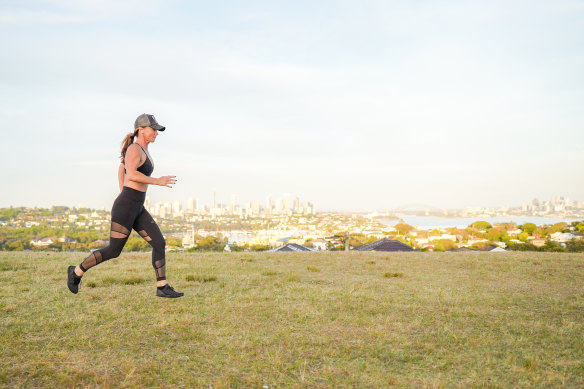
Rachel Stanley recommends considering your cadence when running.
3. Cadence
Increasing cadence, by taking shorter, faster steps, is another way to combat over-striding and helps us stabilise, says Stanley. It’s for this reason that Stanley encourages new runners, and runners who have experienced injuries to aim for a cadence (step rate) of about 180 per minute.
The magic of 180, Stanley says, is that there is 13 per cent less ground contact time than a slower cadence of 160. Increasing the cadence higher than 180-185 however is too fast for most people to maintain for any prolonged period.
Not everyone agrees that 180 is right for all runners. Height, for instance, plays a role in cadence – it’s a lot easier for someone with shorter legs to have a faster cadence, while taller people typically take longer, slower strides. In fact, recent research shows that while the average cadence among a group of world class athletes is 182, they ranged individually from about 160 to over 200.
4. Breathe
When we lose our breath, we are also losing form. Williams says that when we go out for a run, we should remain in the aerobic zone (about 70 per cent of our maximum heart rate) for four out of five kilometres or eight out of 10 kilometres.
One way to monitor our exertion, if we don’t have a heart rate monitor for instance, is via our breath. Williams suggests a 3x3 breathing pattern, inhaling for three steps and exhaling for three steps until the final part of the run when we increase to a 2x2 pattern. “You should be out of control only for final sprint,” he says.
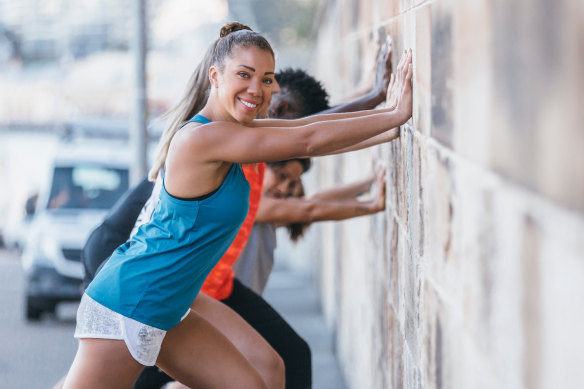
Podiatrist Odette Blacklock.
Our breath also provides the rhythm for our run and podiatrist and athlete, Odette Blacklock adds that breath control equates to body control. Breathing from our diaphragm switches our core on, keeping us stable, elongated and able to maintain alignment when we run.
“If you’re not breathing properly you can’t create energy and you’ll fatigue really quickly and you’ll want to give up,” Blacklock says.
How to prevent injury
By some estimates, more than 621 million people around the world run regularly. Of these, as many as 70 per cent will be injured at any one time.
This causes many people to stop running altogether, blaming the rickety way their bodies feel when they run.
Knee pain accounts for about 42 per cent of running injuries, followed by problems with the foot or ankle (17 per cent), lower leg (13 per cent) and hip (11 per cent). But injury is not inevitable.
In fact, for many of us, our best running years are yet to come.
Sprinters might peak in their mid 20s, but the fastest runners in longer races tend to be 39 or 40, and others don’t hit their peak till 50 or older.
If age is not holding us back then how do we keep our bodies from falling apart when we run?
Physiotherapist Rachel Stanley and podiatrist Odette Blacklock say there are simple ways to prevent most injuries. And contrary to what you may think, it’s less about ice or massage recovery but rather getting your form right to begin with.
Stand tall and stay strong
Postural faults add up every step of the run, Blacklock explains.
“A neutral pelvis is a pelvis that is steady,” she says. If our pelvis tips back or tucks under, the muscles that are attached into our hip joints won’t pull in an optimal way when we move. Similarly, slouching affects our alignment as well as our ability to breathe well.
Elongating our spines when we sit, stand and run, stretching out hamstrings and hip flexors that are tight from sitting for long periods as well as doing abdominal work to strengthen the core will all help us to feel better and lessen the chances of hurting ourselves when we get up and go for a run.
Simply becoming aware of our bodies and how we move “makes a massive difference”, Blacklock says.
Blacklock also suggests standing on one leg and jumping up and down on one leg at a time in front of the mirror to see what happens with our knees and feet. The more we practise these exercises, the more stable we will become.
Start slow, but move your feet fast
Stanley adds that starting out slowly, building up strength and mobility and paying attention to technique are also key to a running journey that is pain-free.
“I want people to smash it,” she says, and the fastest way to do this is to go slowly and build up.
Landing on the mid or forefoot, instead of the heel, and spending less time on the ground by increasing cadence (steps per minute) are two quick ways to improve technique and reduce injury risk.
When we pay attention to these areas, we can go the distance, Stanley says: “Like a car if we take care of the components, we are designed to last.”
Get strong and stretch
Strength and mobility enable us to run well in multiple ways, Rachel Stanley says.
“When you increase your core strength, your body is stable, you’re moving properly and you’re more robust. You’re not using compensatory movement patterns – the wrong muscles for running – which are more likely to lead to injury,” Stanley says.
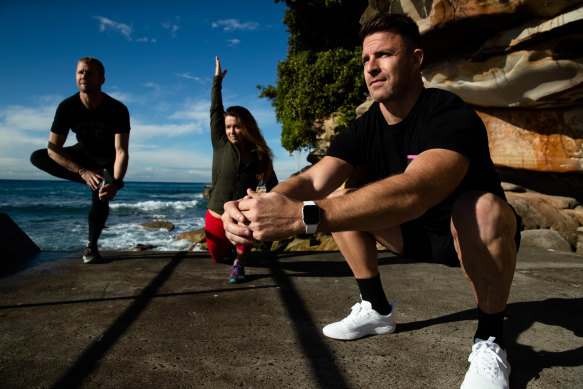
Bend and stretch and strengthen your body to minimise the risk of injury: Trent Knox, Rachel Stanley and Todd Liubinskas.Credit: Janie Barrett
Mobility, on the other hand, allows us to move freely when we run. If we can’t move easily, then we will not be able to run with efficiency or speed, we increase our risk of injury and running is unlikely to feel good.
“I liken that tightness to wearing a wetsuit,” Stanley says. “Do you want to run down the high street with a four-millimetre wetsuit? Mobilisation takes off your internal wetsuit.”
It is for these reasons that Stanley believes that, for injury prevention, the biggest thing we can do is strength work followed by mobility.
Todd Liubinskas, director of the 440 Run Club and founder of Feel Fit in 4 Weeks, adds any strength and mobility we do will benefit us when we run, whether it’s pilates or push-ups, a strength session at the gym or some squats, a walk, a swim or yoga.
For new runners, Liubinskas suggests adding in one strength session a week to start, slowly building to two as our bodies adjust.
According to Liubinskas, these are the top four strength exercises for runners:
- Lunges are good for your hip flexors and quads, and they activate your core. Try: 8-12 on each leg.
- Calf raises prevent injury and improve speed and strength. Place your hands against a wall to balance, lift up on your toes and lower. Try: 15-20 on each side.
- Good mornings are great for stretching and strengthening your hamstrings. Stand, with your feet hip-width apart, your knees slightly bent and touch your shoulders with your hands. Keeping your back straight and your chin up, bend forward until you feel your hamstrings engage and lift back up. Try: 10-12.
- Squats provide strength and mobility for your glutes and quads, as well as a release through the achilles. Try: 15-20.
Aim for three sets of each exercise above as a strength session or one set as a pre-run activation.
And the following are the best mobility movements for runners:
- Pigeon stretch releases your hip and lower back. With your foot resting on your opposite knee, poke the bum back and lean forward, allowing your weight to melt into the heel. Try: 15-20 seconds each side, three times.
- Hamstring stretch releases through the back of your leg. Sitting down with your legs extended, lean forward, while keeping your spine long and reach towards ankles or toes. Try: Three rounds of holding for 15-20 seconds.
- Hip flexor stretch releases through the front of your hips. Lunge keeping your back knee on the ground and your front knee at a 90-degree angle, tucking your tailbone under. Try: Three rounds of holding for 15-20 seconds.
- Calf release is often overlooked but very important for injury prevention. Massage the calf area with your fingers and your thumb, working down towards your feet. Try: Three rounds of 30-45 seconds on each calf.
Fuel yourself
What to eat
The food you eat is the fuel to keep your body performing at its best – and to keep you enjoying yourself. Simone Austin, an advanced sports dietitian and author of Eat Like An Athlete, says that runners need to prioritise getting enough protein in their diet to maintain and repair muscle. She recommends spreading your intake through each meal, for example by having beans or milk at breakfast; tuna, eggs or chickpeas at lunch; lean meat, fish or lentils at dinner. And you need to be eating plenty of plant foods to power yourself with vitamins, minerals, antioxidants and fibre. “Your body needs to repair and look after your immune system which comes under some stress when exercising,” Austin says. Also make sure you’re getting good quality carbohydrates day-to-day (wholegrain bread, oats, brown rice, wholemeal pasta, quinoa, potatoes, corn, fruit) and fats (a handful of nuts, avocado, extra virgin olive oil).
Keep yourself hydrated, too, to maintain your energy and performance. Austin’s advice is to check your urine is a fairly clear colour and to drink when you’re thirsty. You should be going to the toilet roughly every 3-4 hours.
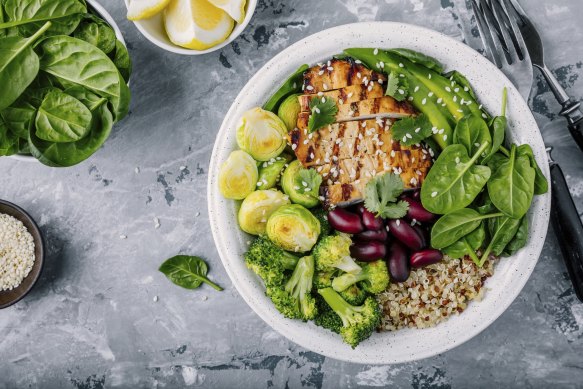
Eating well is an important part of your running performance.Credit: iStock
When to eat
While some people find they can run shortly after eating without getting an upset stomach, for most people, a meal 2-3 hours prior is generally recommended. After the run, to gain muscle, Austin suggests having a bite within 1-2 hours.
If you’re training for five kilometres, Austin says you don’t need to eat a lot more food, but it’s smart to look at when you’re eating to fuel your runs. “If running in the morning you might get up and split your breakfast into two. Have some before and the rest after, so you have pre and post run fuel, rather than adding in more. It could be a banana before the run and then your porridge when you come home. If running in the afternoon you may have lunch two hours before and leave a piece of fruit to eat an hour after the run.”
For 10-kilometre runners, an additional snack post-run is a good idea to replace your fuel. It can also help stop you losing muscle mass. Try a glass of milk and crackers with peanut butter or a bowl of soup.
Your race day diet
Don’t gorge before the big race. “If you overeat you will feel sluggish and won’t sleep well if loading the night before,” Austin says. If you’re running five kilometres, Austin recommends eating normally the day before. Ten-kilometre runners can add in some extra carbohydrate but don’t go overboard. “You don’t need a mountain of pasta the night before. Have a normal bowl and a top-up of a slice of toast before bed if the run is early in the morning. But if it is later in the day you will be eating breakfast to top up carb stores anyway.” Austin also urges people to avoid high-fat foods before the race because they take time to digest and make you feel heavy: “This is not the time for takeaway.”
On the day itself, if the race is first thing, have a light breakfast. “Two hours before is ideal but no need to get up at 5am ... Simply have a snack before bed the night before and have some toast or yoghurt and fruit in the morning. Having some water or other fluid is important.”
During a five or 10-kilometre race, it’s up to you whether to drink water. Do so if you need to. If you’re going for speed, you might want to stick to drinking before and after the run. You’ll mainly be hydrating with water, but grab a sports drink if you’re intensely pounding the pavement or the weather is warm.
After a 10-kilometre race, have a snack within an hour as you would when training. Then have your main meal 2-3 hours after the run.
Gear up
The beauty of running is that you don’t need much to start. But there is a lot of value to equipping yourself with great gear: it can be motivating, more comfortable and, in turn, improve your performance.
Shoes
What you wear on your feet is the most important piece of this puzzle. Sports podiatrist Odette Blacklock says that a well-fitting shoe will prevent injury – from your feet to your knees, hips and back – and give you confidence on race day. She adds that when running, your foot strike produces a force of more than three times your body weight, so shoes help reduce that shock.
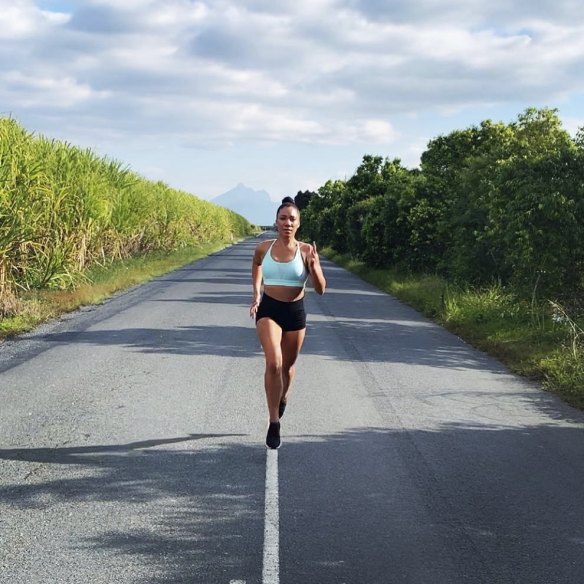
Start with the right shoes, says sports podiatrist Odette Blacklock.
“The best running shoe is forever a hotly debated topic,” says Blacklock. The reality is that it’s extremely individual, so don’t buy shoes simply based on friends’ recommendations, nor from online without trying on, she warns. Rather, you need a shoe that’s exactly the right size, and is based on your foot type and running strike. Your best bet is to head to a store that assesses you, lets you try a pair and take it for a run, Blacklock says. Many retailers also allow you to exchange a shoe if it’s not suitable after being tested out, so it’s worth checking this. Blacklock recommends looking for these features: a wide toe box with ample room to move and splay your toes; light-weight and flexible at the front; a firm heel that doesn’t collapse under pressure. RunRepeat has a lot of helpful resources on running shoes on its website. Blacklock’s top all-rounder running shoe brands are Asics, New Balance, Brooks and Hoka.
As frustrating as it may be, you’ll need to replace your runners every 6-12 months. “The reality is spending $100-$300 on a shoe should be seen as a small investment for how much you get out of them. The right shoe can also save you hundreds if not thousands in long term health-related injury costs,” Blacklock says. “If you want to save money, keep an eye out for last season’s shoes as most of the better quality shoes don’t change much over time.”
Socks
The right socks can make or break your shoes, Blacklock says. You want to feel secure without slippage or irritation. “The aim is to choose a sock that reduces friction and moisture, to prevent dermatological issues such as athlete’s foot, blisters and calluses.” The best fabric is a synthetic blend that wicks moisture away and stays in place around the ankle. Avoid loose fitting cotton socks. Blacklock’s favourite pair is Under Armour’s Run No Show Tab socks.
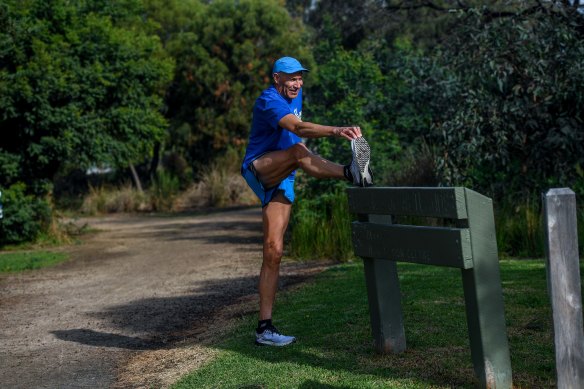
Sean Williams gets into a hamstring stretch. Credit: Joe Armao
Clothing
Moisture-wicking synthetics are ideal for running: they’re more breathable and help you regulate your body temperature because the material quickly absorbs sweat from your skin and dries. When the weather is warm, you want to feel as light and comfortable as possible, Sean Williams says. That might mean a singlet or T-shirt and shorts.
In the colder months, you may want a second layer over your top half. If so, Williams recommends a lightweight running jacket. Otherwise just wear a long-sleeve running top. And you’ll probably want to wear long tights. Williams says the key to cold weather running in Australia is the right accessories. “There’s nothing worse than being too cold for the whole journey,” he says. Consider getting yourself some gloves to keep your fingers toasty. Also look into getting a headband, ear muffs or a beanie. A neck buff can also be handy. You can always remove these accessories and put them in a pocket if you need to.
A Rebel Sport spokesperson says its most popular brands for running apparel are Nike and Under Armour as they’re functional, sleek and use high-performance fabric. Williams adds that you don’t need to spend a fortune on apparel, and recommends waiting for sale prices. He also suggests checking out budget-friendly sports giant Decathlon. But he adds: “The more running you do, the more you’ll want the good gear.”
Watch
Williams is a big fan of running watches because they offer you detailed reports on your runs and allow you to easily monitor your progress. A JB Hi-Fi spokesperson says the key measures they give you are your pace, distance and overall time. They also track your heart rate, so you know your exertion levels, and changes in terrain elevation. More advanced watches come with extra features, like a cadence-counter and calculating optimal recovery time. The most popular brands are Garmin, Apple, Fitbit, Suunto and Samsung (and they’ll sync up with running app Strava). It’s worthwhile getting a watch that you can play music from, too, so you don’t have to carry a phone. Williams says while some people use their phone to track their runs – often using only the app Strava – it can be a nuisance to carry. His favourite watch is the Garmin Forerunner 235, which you can find for about $380. “You don’t need to be paying double, triple that,” Williams says.
Headphones
Runners tend to prefer wireless earbuds to avoid getting their arms tangled in cords and falling out; neckband styles are OK for this too. JB Hi-Fi’s spokesperson says the top brands are Jabra, JBL, Sony, Under Armour and Bose. They recommend getting a pair that’s water (and sweat!) resistant with a nice, secure fit (some brands come with different sized bud attachments) to avoid having it slip around in your ears. Don’t choose noise-cancelling headphones because you want to stay alert. Better yet, look for ones that have an ambient-aware mode to amplify external sounds.
Dial up the enjoyment
Get a buddy
An easy way to make running more fun is by going with a pal. Clinical psychologist Tamara Cavenett, president of the Australian Psychological Society, says not only does a running buddy keep you accountable, they also distract you from any desire to stop. “You’re socialising and connecting on a common interest and it will increase your level of commitment, so it’s a really good way of improving your mood,” Cavenett says. Or, take it online: you can join our running club on Strava.
All in the ears
There’s nothing quite like your favourite song coming on to pep you up on your run. It’s no secret that music is an excellent motivator. Matthew Bourke, a Victoria University PhD candidate in exercise psychology, says it distracts you from noticing negative physical sensations. He points to research showing that people tend to find exercise more pleasurable and less difficult when listening to music, and their performance improves too, particularly with high-tempo music.
We’ve curated a Spotify playlist based on some of the favourite running songs of our experts, and runners in our team. We hope you enjoy it.
Of course, not everyone likes listening to music. Some prefer to engross themselves in a podcast or a great audiobook. Bourke says while these are unlikely to boost performance (they’re not exactly high tempo), they certainly can have a soothing effect and decrease your perceived exertion. In other words, what pain?
A dose of mindfulness
Mindful runs can be a really lovely addition to your routine, Cavenett says. Rather than focusing on your pace and distance, or getting distracted by music or worries that are on your mind, you’re turning your attention to your surroundings, your breath, your body and your movement.
It takes practice, Cavenett says, so start with 5-10 minutes and gradually increase. Try to take deep breaths and notice how it feels; notice the minute detail of the trees you’re running by, the ground beneath you. You’ll probably find your mind will wander a few times, and that’s perfectly normal, Cavenett says, it’s just about realising that and bringing your attention back. “In winter I’m noticing the feeling of the rain on my skin, watching my breath in the cold air, looking at the waves and seeing how they’re so dark and choppy,” she says. “There are so many things in the here and now that we usually miss.”
Make the most of your health, relationships, fitness and nutrition with our Live Well newsletter. Get it in your inbox every Monday.